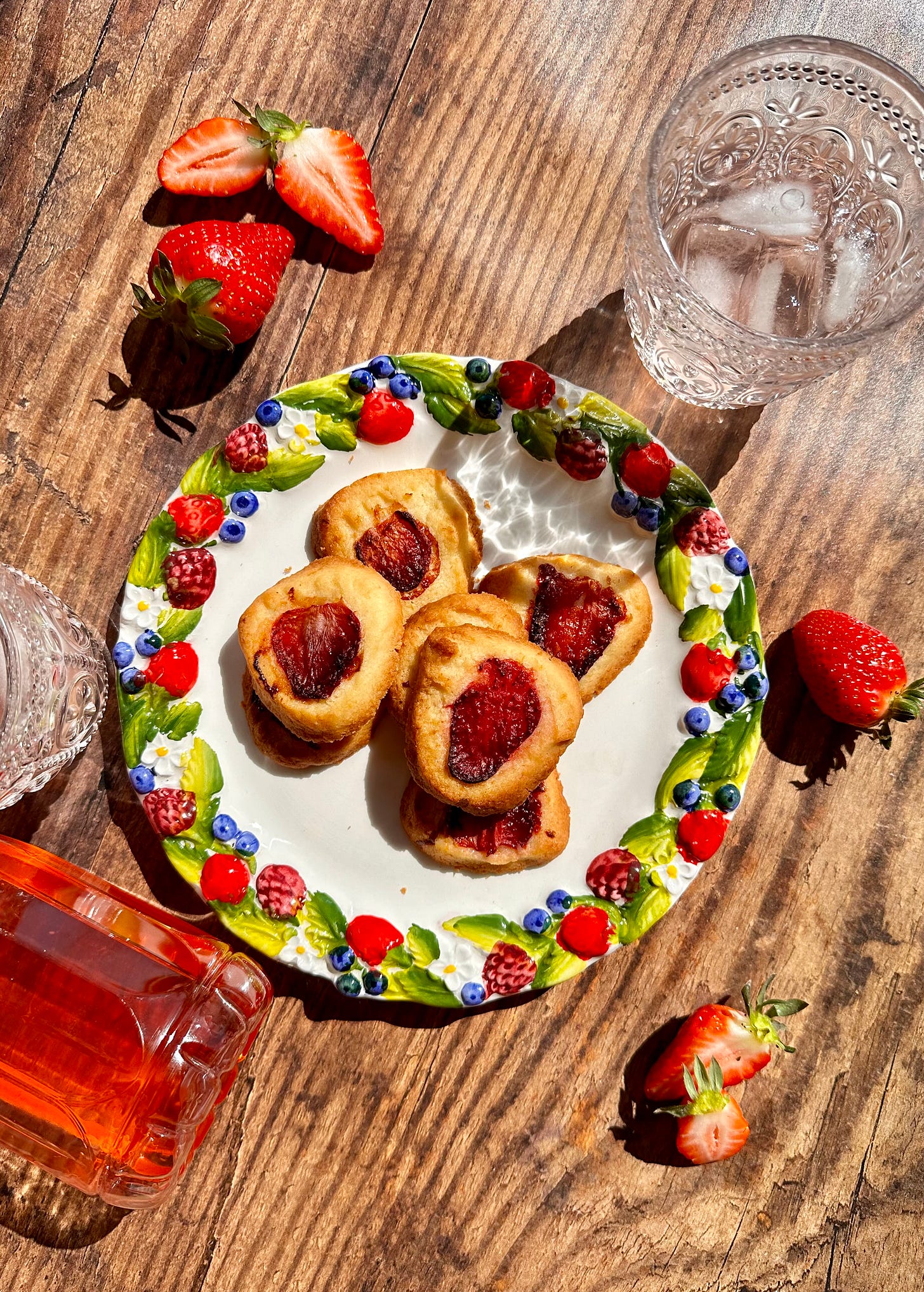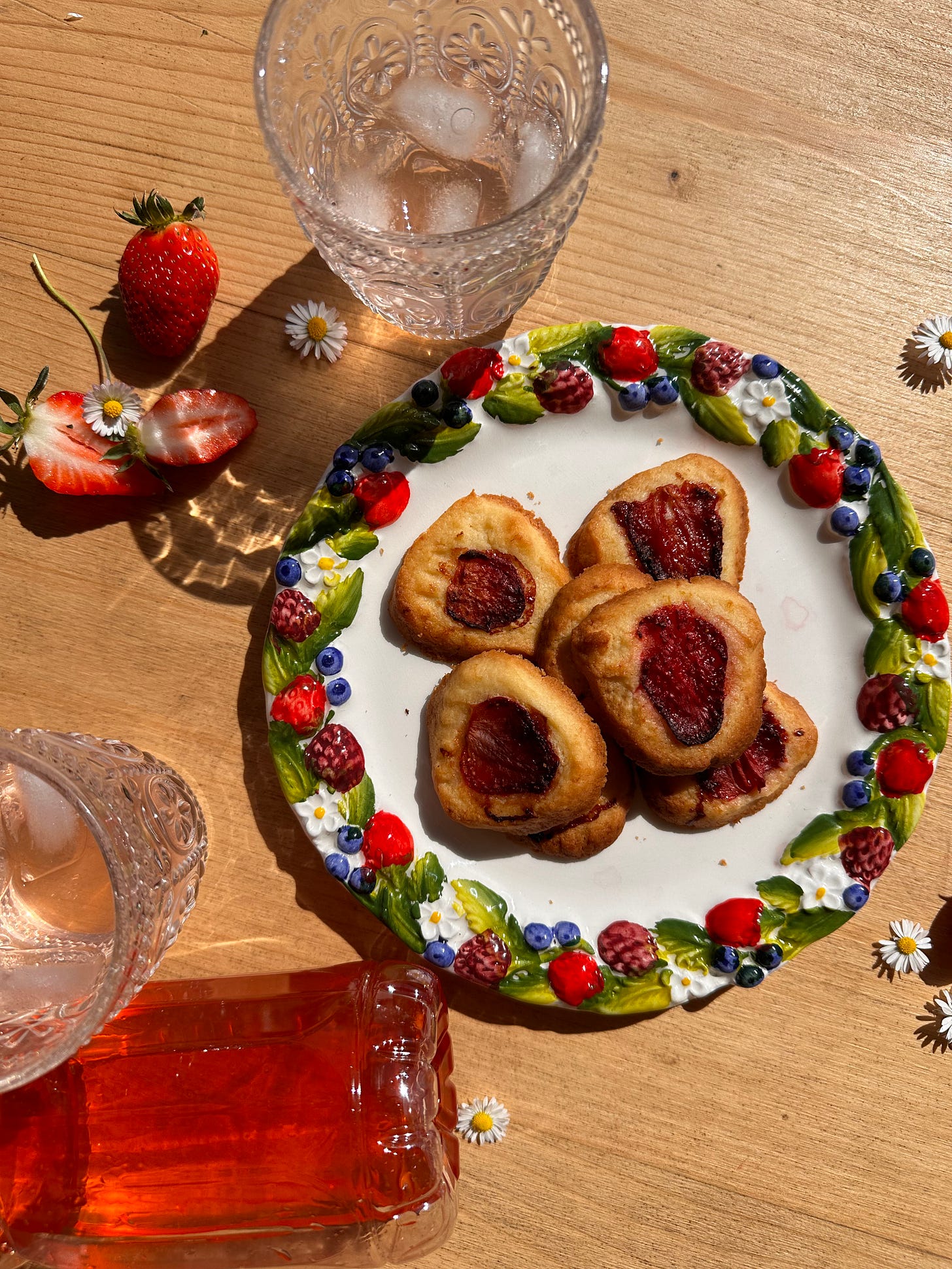June #1 - Strawberry and lemon shortbread biscuits
Could it be the best fruit?
HISTORY:
Wild strawberries have been growing for thousands of years! Latin writers in Ancient Rome described them as medicinal (used to treat depression) or decorative plants. They eventually found their way into personal gardens around the 13th century.
The garden strawberry we know and love today is a French–British hybrid: a cross between the small, sweet North American strawberry brought over in the 17th century and the large, rather tasteless Chilean strawberry introduced by a spy in the 18th century.
FUN FACTS:
Strawberries belong to the same botanical family as roses.
Strawberries and cream were first served at the court of Henry VIII.
Dehydrated strawberries have been part of every NASA mission since the 1960s, including Apollo 11, as a source of anthocyanins and a comforting smell of home.
Belgium has an entire museum dedicated to strawberries.
HOW TO COOK STRAWBERRIES:
Raw:
Rinsing strawberries speeds up spoilage, so rinse just before eating. Store them out of the fridge and away from bananas.
Eat them as is, with a bit of cream and sugar, or with vanilla whipped cream or mascarpone.
They also add a lovely sweetness and acidity to salads
They make a great salsa with lime and spring onion:perfect with tacos, ceviche or white fish.
Got green strawberries? They’re fantastic pickled (use a 1:2 ratio of vinegar to water with salt, sugar, black pepper and coriander seeds) or turned into chutney.
Cooked:
Chop and heat with a sprinkle of sugar (microwave or medium hob) to make a compote for porridge, yoghurt or cakes. Slice thinly and dry in the oven at 100°C to use in biscuit doughs, granola, cereal bars, cakes or muffins.
For jam: cook strawberries with 40% sugar and a squeeze of lemon juice until it reaches setting point (test with a teaspoon on a cold plate, if it wrinkles when pushed, it’s ready).
Use strawberry tops to make a syrup by boiling equal parts water and sugar with the tops, then cooling. Great for spring cocktails or mocktails like mojitos and margaritas.
Strawberries pair well with: goat’s cheese, Emmental, mozzarella, cheddar, mustard, basil, chorizo, seafood, yoghurt, raspberries, mango, banana, peaches, dark chocolate, lemon, lime, cava, whisky, sweet vermouth and champagne.
Fancy trying my strawberry recipes?
Lemon & strawberry shortbread: scroll down for this week’s recipe
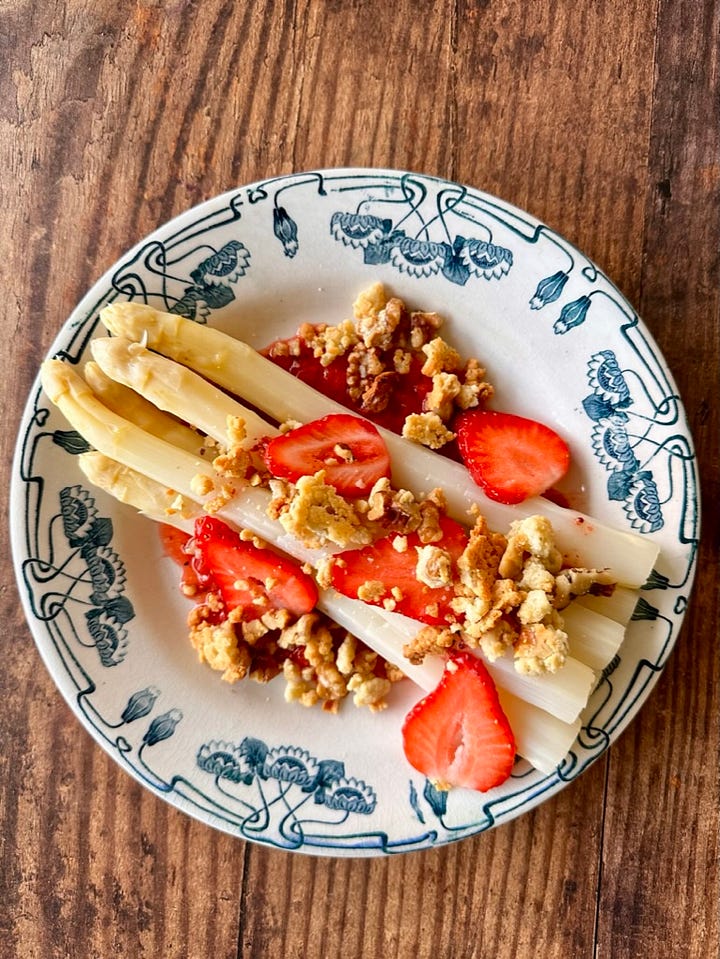
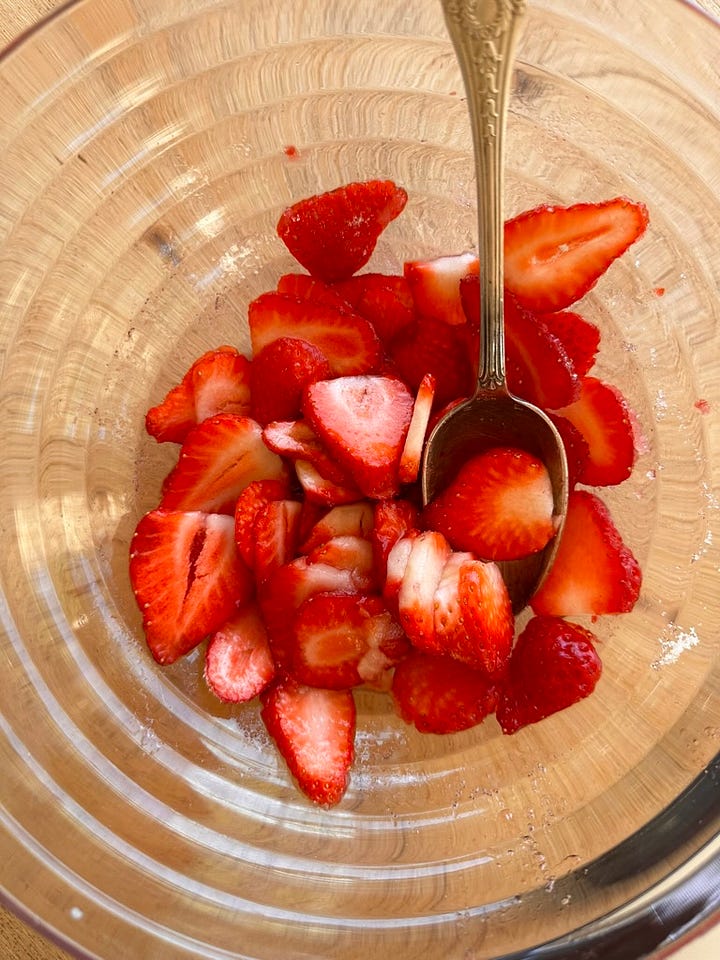
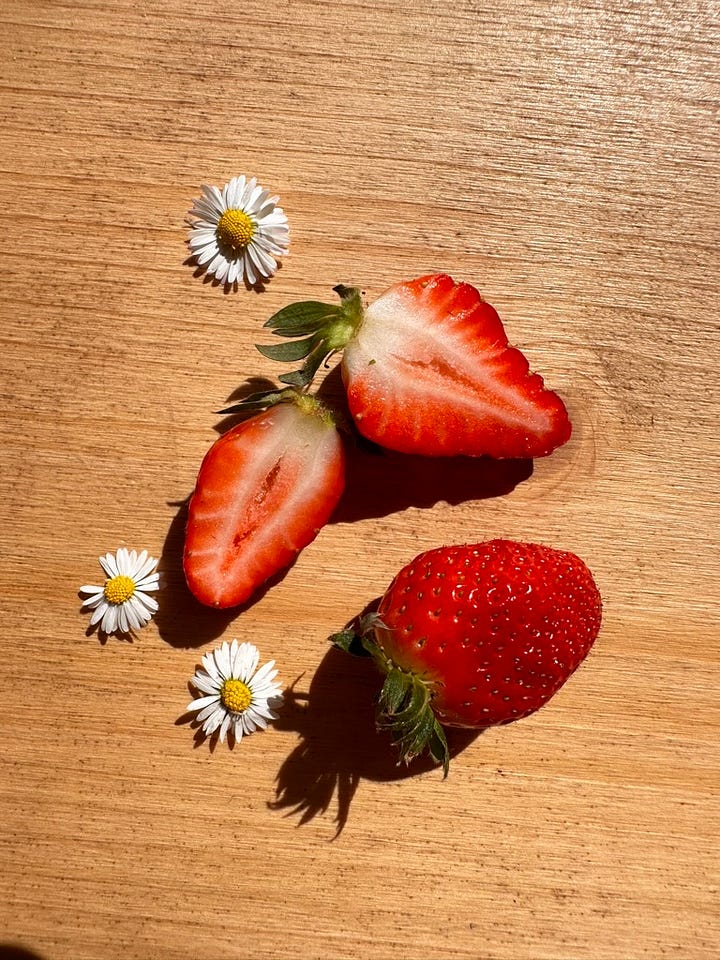
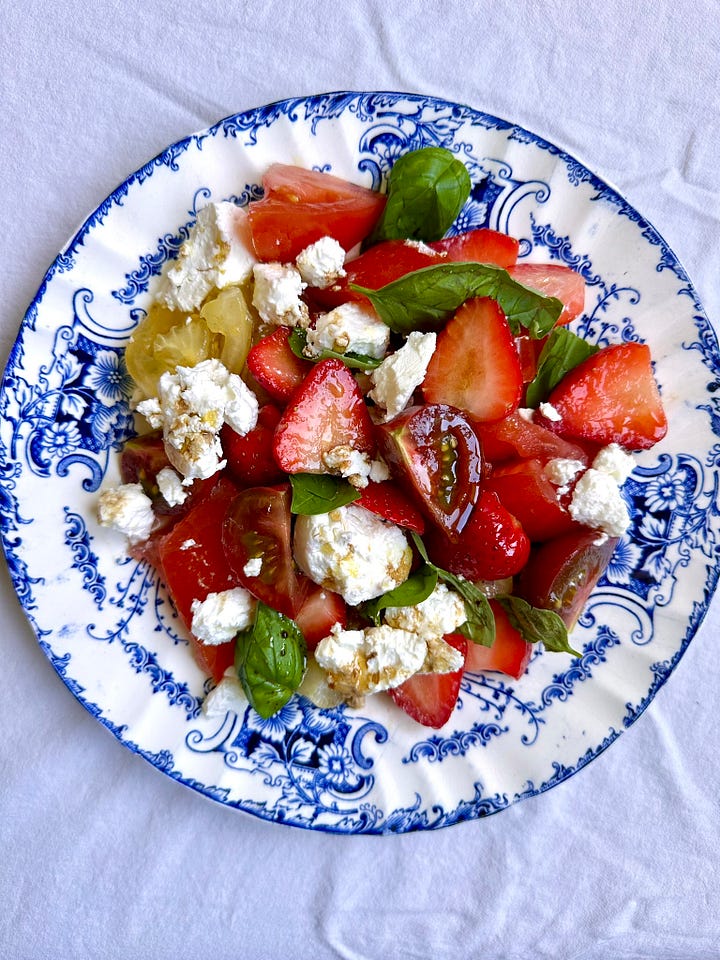
MOOD FOOD - HAPPY:
Folate: A deficiency can increase the risk of low mood and depression.
Vitamin C: Helps convert dopamine to noradrenaline—low levels of which are associated with depression.
Anthocyanins (antioxidants): Support cognition and focus.
Other antioxidants & phenolic compounds: Reduce oxidative stress and support brain health.
Did you know my paid subscribers also get a recipe each week featuring the spotlight ingredient?
For only £3.99/month, paid subscribers get access to:
A new seasonal recipe every week.
A cook along video for the recipe.
Full access to my archive of newsletters and recipes.
You can unsubscribe in one click.
This week’s recipe for paid subscribers:
Lemon & Strawberry Biscuits with Strawberry & Elderflower Cordial
A low-waste recipe using every bit of the strawberry! These lemony, melt-in-the-mouth biscuits pair perfectly with a sweet, floral cordial. Ideal for a calm spring afternoon.
Ingredients (Makes approx 18 biscuits):
Strawberry & Elderflower Cordial:
10 heads of elderflower
250g water
250g sugar
Strawberry tops (from 250g strawberries)
½ lemon, juiced
Dried Strawberry Slices:
250g strawberries
15g sugar
Lemon & Strawberry Shortbread Biscuits:
150g plain flour
100g salted butter
1 lemon, zested
½ lemon, juiced
50g icing sugar
Method:
Start with the cordial:
Forage the elderflower heads and shake gently to remove insects. You can use full heads or pick off just the flowers, just remove branches and leaves.
In a saucepan, combine sugar and water. Stir until the sugar dissolves.
Add elderflower heads. Zest the lemon and set zest aside for the biscuits. Juice half the lemon into the pan.
Add the strawberry tops.
Bring to a boil, then remove from heat and allow to cool. Ideally, leave to infuse overnight.
Strain into a jug.
Next, prepare the strawberry slices:
Slice the strawberries thinly and mix with 15g sugar in a bowl. Cover and leave for at least 30 minutes (or overnight).
Strain the syrup into your elderflower cordial. Reserve the slices for your biscuits.
Your cordial is now ready! Try it with soda, tonic, or mix into cocktails like a spritz or mojito.
Make the dried strawberry slices:
Preheat the oven to 80°C.
Line a baking tray with baking paper or a silicone mat.
Lay out the strawberry slices in a single layer.
Bake for 1 hour. Flip halfway if you’d like a chewy "leather" texture. Bake for an additional 10–20 minutes if needed until fully dried and just starting to brown.
Make the biscuits:
Preheat oven to 180°C.
Soften the butter (microwave in a bowl for 10–20 seconds).
Sift in the icing sugar and mix with a wooden spoon.
Add lemon zest and juice (the other half lemon). Don’t worry if it splits, it’ll come together again.
Sift in the flour and stir to form a dough.
Place dough onto clingfilm, roll into a sausage shape, and chill for 30 minutes.
Slice into 1-inch discs.
Lay on a baking sheet, press a strawberry slice into each one with a fork.
Bake for 10–12 minutes until golden on the edges.
Cool on a wire rack and serve with your cordial. Bon appétit!
Questions about method, substitutes or anything else?
Drop me a message, I’d love to hear from you!

